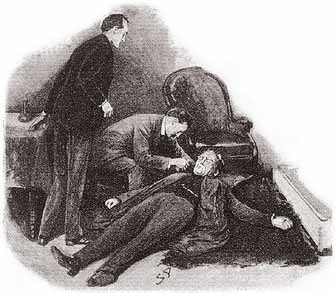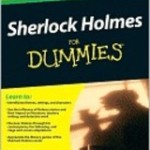A Scion Society of The Baker Street Irregulars

Data! Data! Data! – The Priory School
“‘Data! Data! Data!‘ he cried impatiently. ‘I can’t make bricks without clay.’”
– The Adventures of The Copper Beeches (COPP)

Illustration by Sidney Paget in The Strand Magazine (February,1904)
This column is composed of material (Data!) developed for a short course called Appreciating Sherlock Holmes that I taught twice a year in the Community Education Life Enrichment Program for a local community college. It is composed of “points of information” that are common to many / most / all of the 60 Canonical stories.
The information here has been researched by me or borrowed / stolen from many efforts of other Sherlockians.
HERE GOES The Adventure of the Priory School
 CHRISTOPHER MORLEY SAID . . .
CHRISTOPHER MORLEY SAID . . .
“Dr. Watson always thought the startling arrival of Dr. Thorneycrofy Huxtable, M.A., Pd. D., one of Baker Street’s most dramatic moments. What had happened to cause such despair and fatigue in this burly schoolmaster, principal of the famous Prior School and author of Huxtable’s Sidelights on Horace? Holmes was able to give interesting sidelights on cloven feet. Experts have observed some differences between the English and American printing of Watson’s sketch map of the Derbyshire moor.”
DUMMIES SHORT SUMMARY (From Sherlock Holmes for Dummies by Steven Doyle & David Crowder)
“Kidnapping, murder, and high society result in a case with Holmes becoming a very rich man.”
PUBLISHING HISTORY
- This was the 54th of the 60 stories published in sequence
- It was first published in the U.S. in Collier’s Weekly on January 30, 1904
- It was published in England in The Strand Magazine, February, 1904
- It is part of The Return of Sherlock Holmes collection published by George Newnes, Ltd., London, 1905 and by McClure Phillip & Co., New York, 1905
- The British Illustrator was Sidney Paget
HOW MANY WORDS?
According to C. E. Lauderback, 1960 – – found on SHERLOCKIAN.NET website created by Chris Redmond and at 11,507 words PRIO has the 54th most words (#1 is VEIL – 4,499, #56 if NAVL – 12,701)
THE BEST OF SHERLOCK HOLMES (How do Sherlockians rate this story?)
1927 – Arthur Conan Doyle listed it as 10th on his list of 12 favorites
1954 – The Baker Street Irregulars voted it as #9 on their top 12 favorites
1999 – The Baker Street Irregulars voted it 13th of the 56 short stories
1999 – The Sherlock Holmes Society of London voted it 15th of the56 short stories
CLASSIFYING THE CASE (From the Wandering Gipsies of Grimpen Mire of Decatur, Alabama)
This case is one of 3 classified as a disappearance by abduction. The other 2 were LADY & SOLI
CHRONOLOGICALLY SPEAKING
Doyle was often very vague about stating WHEN the tale took place and included few contemporary references to help. Whether this was done intentionally or unthinkingly, the dating of events in the Canon is a very popular pastime pursued by several of our “scholars” researching and justifying their results to no end. We will again default to William Baring-Gould’s dating of Thursday, May 16 to Saturday, May 18, 1901. Chronologically speaking this makes it 49th of the 60 stories in time. This means that Holmes is 47 and Watson is 49.
WHAT ELSE HAPPENED IN YEAR 1901?
It is always interesting to see what else in happening at the same time as the stories.
- Queen Victoria dies, January 22nd, accession of Edward VII as King-Emperor.
- Northern Nigeria becomes British protectorate.
- Creation of North Western Frontier Province in India.
- Uganda railway reaches Lake Victoria.
- Robert Falcon Scott commands the Discovery on Antarctic expedition.
- First electric trams from Shepherds Bush to Acton and Kew Bridge.
- First British submarine launched at Barrow-in-Furness.
- Boxing is recognized as a legal sport in England.
- Taff Vale case: Trade Unions in Britain liable for actions of tort.
- Scotland Yard creates a fingerprint archive
- Peace Protocol with China after Boxer Rebellion.
- U.S. President McKinley assassinated; succeeded by Theodore Roosevelt.
- Law of Associations: gives French Roman Catholics the right to form associations, if neither secret nor illegal.
- Labor Councils in France to settle disputes between masters and men.
- Franco-Italian agreement defines spheres of interest in the Mediterranean.
- Compulsory military service established in Sweden and Norway.
- New constitution in Serbia issued by Alexander.
- U.S. Steel Corporation organized under J.P. Morgan and Company, bankers.
- Opening of Trans-Siberian railway.
- Hay-Pauncefort Treaty gives U.S. power to build and police the Panama Canal if it remains open to shipping in peace or war.
- Cuba becomes a U.S. protectorate
- First Nobel prize awarded in Stockholm on 5th anniversary of Alfred Nobel’s death
- Guglielmo Marconi received signals transmitted from England to Newfoundland
- Kipling writes Kim.
- Frank Norris, U.S., writes The Octopus.
- Marconi transmits Morse wireless signals from Poldhu, Cornwall to St. John’s, Newfoundland.
- Becquerel discovers dangerous effects of radioactivity on humans.
- First isolation of the hormone adrenalin.
- Peter Cooper-Hewitt produces mercury vapor lamp; invented by Arons in 1892.
- First Texas oil gusher at Spindletop, Beaumont
- New York state first to require automobile license plates
- Stock market crash
HOLMES AND WATSON – PERSONAL INFO
Holmes and Watson are sharing quarters at 221B.
DRAMATIS PERSONAE
- DUKE OF HOLDERNESS
- LORD SALTIRE (ARTHUR), ten year old son of the Duke
- JAMES WILDER, secretary to the duke and his illegitimate son.
- THORNEYCROFT HUXTABLE, M.A., Ph.D., etc., proprietor and owner of the Priory School.
- CAUTER, Roommate of Arthur
- HEIDEGGER, German master at the Priory School.
- REUBEN HAYES, proprietor of the Game Cock Inn and accomplice of James
- HAYES, wife of Reuben – a good woman but completely under her husband’s control
- EDITH, (THE DUCHESS OF HOLDERNESSE) –
- AVELING –
- THE EARL OF BLACKWATER –
- FERRERS –
- LORD LEVERSTOKE –
- SIR CATHCART SOAMES –
“QUOTABLE SHERLOCK”
- Holmes to Watson about to search the moor – “A bicycle, certainly, but not the bicycle,” said he.
- “I am familiar with forty-two different impressions left by tyres.
- Holmes to Watson soon after finding the body – “Let us try to realize what we do know, so as to make the most of it, and to separate the essential from the accidental.”
- Holmes to Watson about the absence of footprints – “It is impossible as I state, and therefore I must in some respect have stated it wrong.”
- Holmes to Watson after discovery of the horse – “This case deserves to be a classic.”
- Holmes to the Duke of Holderness – “I must take the view, your Grace, that when a man embarks upon a crime, he is morally guilty of any other crime which may spring from it.”
- Holmes to the Duke of Holderness and Watson – (1st was check for £6,000) “This is the second most interesting object that I have seen in the North.”
HOLMES’ FEE
£12,000. For this sum, the Duke not only got his son back and the mystery solved, but he benefited from Holmes’ silence about the matter. This makes Holmes a rich man.
SHERLOCK ON THE BIG SCREEN & THE LITTLE SCREEN
1921 The Priory School was the 14th of the Sherlock Holmes short silent movies staring Eille Norwood as Holmes and Hubert Willis ads Watson.The National Film and Television Archive at the BFI has viewing copies of this film but it has not been released.
1986 The Priory School was part of the BBC/Granada series with Jeremy Brett and Holmes and Edward Hardwicke as Watson
SHERLOCK HOLMES IN DISGUISE
The Master of disguise used the deception of being disguised 14 times in 11 of the 60 stories, but none were needed in this tale.
UNRECORDED CASES (That involved Holmes)
Watson would tease / torture his readers with “I know something you don’t.” Oh my, how Sherlockians love this category. I have in excess of over 150 examples in my collection. We have 2 in our story.
- The Case of the Ferrers Documents
- The Abergavenny murder
FAINTING IN THE CANON (courtesy of Sherlockian Karen Murdock)
Fainting is extremely common in the Canon, appearing, in some form, in 37 of the 60 tales. In 21 cases someone actually faints. In 22 cases someone almost faints. And in 5 cases someone pretends to faint. All these near-faints and faked faints aside, however, twenty-five characters in the Canon actually do faint (2). The gold medal for Best Faint goes to Thorneycroft Huxtable with his over-the-top-and-under-the-table entrance to 221B in PRIO. We will use the good doctor’s words. “We have had some dramatic entrances and exits upon our small stage at Baker Street, but I cannot recollect anything more sudden and startling than the first appearance of Dr. Thorneycroft Huxtable, M.A., Ph.D., etc. [. . .] his first action, when the door had closed upon him, was to stagger against the table, whence he slipped down upon the floor, and there was that majestic figure prostrate and insensible upon our bearskin hearthrug.”
HOLMES’S PUBLISHED & PROJECTED WORKS
Sherlockians love this topic and are regularly searching for these items. Holmes mentions published or projected works in 11 of the stories, but none are mentioned here.
IS THERE A DOCTOR IN THE HOUSE?
Victorian London, in Holmes’ time, had approximately 1 doctor for every 100 people. 31 of the 60 tales have a doctor in them. This, of course, does not count Holmes’ Boswell. This listing is by Leslie Klinger in the Winter, 2015 edition of the Baker Street Journal.
- Unnamed – treated the landlady of “The Red Bull”
NEWSPAPERS (Real and Fictional)
Though included in only 20 tales some of our more obsessed Sherlockians love this one. Our story has one.
- Globe – The oldest evening London paper. Became Conservative after a long-time supporter of Whigs.
ANNOTATED SHERLOCK
The 60 Sherlock Holmes stories used English as spoken in England from the 1880’s until the 1910’s. Some words are foreign to us today and need a “contemporary translation.” For example, our story has
- “Lord Lieutenant” – the principal officer of an English county (appointed by the crown) controls the appointment of justices of the peace and issues commissions in the local military organizations
- “corn-chandler” – a dealer in corn and other grains
- “break the entail” – a restricted course of inheritance – for example, a restriction that property could only be left to the eldest child
- “gorse” – a spiney shrub with fragrant yellow flowers and black pods, also called furze
- “soverign” – a gold coin worth one pound
- “publican” – a keeper of a public house or pub
- “dolorously” – exhibiting sorrow, grief, or pain
- “biscuits” – cookies or crackers
WEAPONS (from A Compendium of Canonical Weaponry by Dettman and Bedford)
… “a means by which one contends against another” … utilized in 57 of the 60 tales (all but CREE, 3STU, & YELL). There are several general categories to classify “weapons” that include: firearms, human agents, cutlery, animals, blunt instruments, extortion, toxin, blackmail, and miscellaneous. In our story, which is short, you will find all of the following:
- Service Revolver – Dr. Watson’s and is mentioned in 13 cases.
BLUNT INSTRUMENTS
- Heavy Walking Stick – Which Reuben Hayes, proprietor of the Fighting Cock Inn and partner of James Wilder in the kidnapping of Lord Saltaire, used to bludgeon to death Heidegger, the German master at the Priory School, where Saltaire was enrolled.
WEAPONS OF EXTORTION, BLACKMAIL AND DECEIT
- Kidnapping – Of Lord Saltimre, the rightful son and heir of the Duke of Holderness, by James Wilder, the Duke’s bastard son, to gain his inheritance.
MISCELLANEOUS
- Gallows – Which awaited Reuben Hayes.
 Frank Mentzel, aka Merridew of Abominable Memory, has been catching up on reading some of the books he has and has just relocated his residence of over 50 years recently.
Frank Mentzel, aka Merridew of Abominable Memory, has been catching up on reading some of the books he has and has just relocated his residence of over 50 years recently.

Sorry, comments are closed for this post.